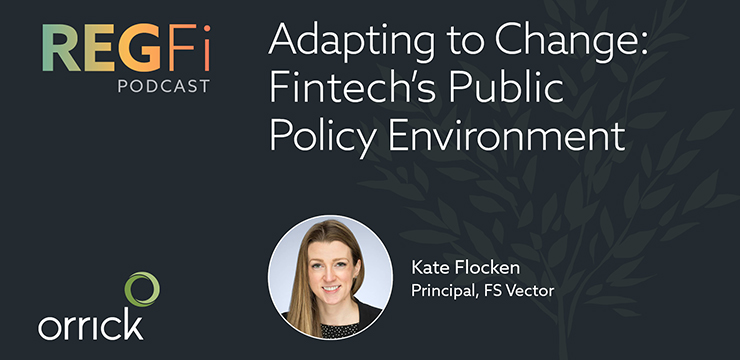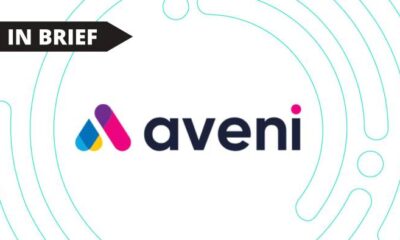Fintech
Episode 37: Adapting to Change: Fintech’s Public Policy Environment

Kate has had extensive legislative experience, including serving on the staff of Senator Rob Portman of Ohio. We’ve asked Kate to join us to get a feel for the current and evolving legislative environment in which financial services firms find themselves. We live in a period of considerable political uncertainty, to say the least, as well as at a time when the ways in which financial services are being delivered to consumers and businesses are also rapidly evolving.
Kate, let’s start on a segment of the financial services industry where you and Sasha and I spend considerable time, namely the world of what has come to be known as fintech. We have all watched fintech grow from a few startups with new ideas into a business in which there are many successful players that have become household names. What is the public policy environment in which those companies, as well as new entrants to the fintech space, now find themselves today?
So regarding the policy environment that fintechs find themselves in, I think you hit the nail on the head with that point. We’ve watched fintech grow rapidly from being a relatively niche industry to a major part of the financial services landscape. When fintech was first beginning to come onto the scene, it didn’t have the full attention of Washington. There was a lot of talk back then about fintech filling in the gaps for the underserved, meeting the needs for those who were not being fully served by the traditional financial services system. And over the last few Congresses, we’ve seen very rapid and tremendous evolvement of how Congress approached these issues and the level of interest that Congress has shown.
So starting out, we had some sort of select members of Congress who served on caucuses and were discussing these issues at events and things like that. Then we saw the development, particularly on the House side, of the fintech and AI task forces on the House side. And now this Congress, we have a fully fledged financial technology subcommittee that also explores AI issues. And I think that the reasons for that increased interest is really mixed. So for some members of Congress, there is a belief in and an interest in the ability of fintech to increase the quality and quantity of financial offerings—high quality, fairly priced and competitively priced offerings for both consumers as well as small businesses. But for others, there’s a lot of concern around predatory products and services, consumer safety, both around their individual consumers’ finances as well as their data. And situations where we’ve seen fintechs run into issues with regulators or run into other issues.
Those issues are typically very loudly discussed in Congress, including sometimes with congressional hearings. And there’s a tremendous amount of scrutiny.
And I think that’s led to a public policy environment that can be pretty challenging. And it’s, I think, much harder now to be a new entrant in this space than it was back then. I think that we saw a lot of really small companies coming on, and now that’s pretty tough. There’s more awareness of fintech and therefore more scrutiny and also a lot less patience for mistakes.
On the regulatory side, it can be similarly hard to decipher policy. When agencies issue FAQs and guidance, there’s not an opportunity to comment the way there is when there’s a proposed rule or request for information. And fintechs and other companies have to focus on what’s being said in hearings, being brought up in public statements and speeches, as well as trying to stay on top of legislation that is being introduced, to try and do their best to prepare and plan for legislation and regulation that might come. I mean, it’s really, really challenging. I want to underscore that, particularly for the smallest of the companies.
As you know, House Financial Services Committee Chair Patrick McHenry has been working on a data privacy bill for years. And has been talking publicly about how he looks forward to working with the authors of the American Privacy Rights Act that is led by Senator Cantwell and Representative McMorris Rogers, which got a lot of excited attention around it a few months back when it was brought up, because it was a bipartisan, bicameral bill that had managed to advance in several areas where there had just been total deadlock for years. And also, as you know, Senate Committee Chairman Brown has also weighed in on the data privacy conversation with his own draft bill, a few years ago, that was much broader than just a Senate banking and financial services bill, so I fully expect both committees will remain staunchly at the center of the debate.
And the same goes for AI issues. I’d say the AI issues have followed a similar path, in that we had AI caucuses on both the Senate and House side that were exploring the impact of AI on a bunch of different issues, financial services included, but also health care, defense, cybersecurity, education, trying to understand broadly how AI was just going to impact Americans, the American economy, global security, things like that. And that’s evolved into broader working groups on the House and Senate side and really Congress-wide action with that recognition that, despite all the challenges that we face and in moving things forward, that this is an area where if America wants to remain competitive, and remain also protected on the negative sides of AI, that they need to be on top of what’s going on.
But where this gets really complicated, as if what I’ve said isn’t complicated enough, I think progress in both of these areas is just going to have to require cross-committee collaboration and not just statements of, “This is what we intend to do…” or “We are looking forward to working together,” but actual concrete action and collaboration. We’ve already talked about the difficult environment that we’re currently in and passing legislation. And when you’ve got bills that involve multiple committees, that complicates things even further. But I think that progress on both of these issues in general is going to require silo breaking, not just within Congress, but certainly the committees are no exception. And obviously, it’s a lot easier for me to sit here and say that than it is to actually make it happen. That is the only path forward that I see here.
There are also actually, I want to note too, that I think that there has been a pattern in the U.S. and even globally whereas regulatory bodies have been trying to get better at regulating technology and overseeing innovation in the various areas that they oversee. There has been more- we’re seeing more inward turning and these agencies focusing on their own technology, recognizing that they actually need to upgrade their own systems. They need to get better at understanding their own needs as well as what is out there. And so that evolvement is a lot less visible to the outside, which may make them seem less active, even though there is still, actually, really positive development occurring internally.
I think that it is less clear now for fintechs on who to talk to and how to access them within the agencies. But there’s still definitely a strong presence within each of the agencies. It’s working hard to understand what’s happening in the market. Where is the innovation happening? What is the demand from consumers, from small businesses, from others? And also, what are they hearing from companies on what they’re looking to build in the future, even if they’re not there yet, including on how are they looking to incorporate AI, for example, into their existing products?
And I think that part of that shift could even be put down to a natural evolution that has followed a more grown-up industry. So fintech has evolved and the regulators are sort of evolving with them and their approach to how they’re overseeing the developments in the space. But as we’ve already talked about a couple of times, it definitely makes it harder for new entrants who might not have the connections and the resources that the established players have. They might just, if they’re trying to come in, especially if they have a new product that they’re not entirely sure where it falls on the regulator spectrum, that can be really, really hard for new entrants to figure out and expensive for them to figure out. And I also think it’s worth noting that there’s evolvement and restructuring in organization that occurs just with every new administration. So, some of the changes might not be so much a reflection of how fintech is seen or less interest in fintech as much as just some shifts around how this particular administration is choosing to engage or to organize themselves.
I also want to note that from the beginning, the offices of innovation, they have a particularly tough task because they’re within these regulatory- they’re regulators, right? So their number one role is safety and soundness and making sure that everything that they’re overseeing is going to be as buttoned-up and safe as possible while trying to encourage innovation. And I think that those offices did a good job of trying to walk that line. As I say, it sounds like I’m talking about it in the past tense, which I don’t mean to. But from those early days to now, to walk that line of really emphasizing, staying on top of the responsible aspect of the innovation, and making sure the companies understood their role in ensuring that what they were doing was responsible, and caring closely for consumer protection, security issues and all of that, which remains a very challenging task for regulators. And again, I just think that can make it seem like they’re less positive on innovation to outsiders than they actually are.
So, we do see some challenges coming out of congressional gridlock and states having to pick things up that they might not otherwise have. But for those new entrants who have the bleak picture being painted for them, it’s worth looking into the different states and what their policies are around certain types of products. Because many of them really do want folks to come to them and to innovate within them and to grow their economies, which I think is just a fantastic tradition in the United States.
Regarding the CFPB, I think that, to your point, like as a kind of first touchpoint, if companies haven’t been paying attention to the CFPB or they think the CFPB won’t be interested in what they’re doing or won’t notice what they’re doing because they’re busy elsewhere… Whatever it is, they need to think again and really be mindful of ensuring the financial health of the consumer is at the heart of basically — not even basically — of every decision that they make. And on the flip side of that, I also think it’s very, very helpful for companies to proactively engage with the CFPB and with other regulators, even if they don’t think they’re directly overseen, or it might not be an issue right now. Or, whatever the reason is, I think that proactive engagement is incredibly valuable, and the earlier, the better. It helps the regulators understand what’s happening in the market, which will lead to them crafting better policy, which is beneficial to everyone across the industry. And it also lessens the risk of companies being taken by surprise when regulators do suddenly pop up and take an interest in them, or want to talk to them or take a look at what they’re up to.
If they’re growing, which is probably the goal for all these companies, they will be noticed, and probably sooner rather than later. So if the CFPB or somebody else is going to be that first touchpoint, I think that these companies should seriously consider making that first move and doing that outreach themselves and just establishing a positive and proactive relationship there. Companies don’t necessarily have to even do that through a direct connection. They can respond to requests for information and kind of engage with regulators in different ways. But I can’t emphasize enough how important I think that proactive engagement is because it signals to the regulators that they are really trying to be positive actors in the space. They’re trying to engage in a helpful way. And it shows that they want to be doing things the right way. And particularly, like we were talking about before, where there might be FAQs or guidance or something that’s not totally clear, that is a great way of starting to bring up those issues in a non-contentious format so the regulators can work to address them.
So on the more certain side, one change that’s coming, that we know is definitely going to happen, is that the House Financial Services Committee Chairman Patrick McHenry is retiring. So no matter what, we will have a different Republican serving as the next chairman or as the next ranking member. And there are several Republicans who are in competition for that role.
On the Democrat side at this point, we expect ranking member Maxine Waters will likely remain at the top, either as the ranking member or potentially in gaining the gavel back. Then on the Senate side, Banking Committee Chairman Sherrod Brown is up for reelection this year. So if he wins, which we expect, he will continue to lead the committee as either the chair or ranking member. But if the Senate flips or sorry, either if the Senate flips or not, he’ll remain at the top. But if he does lose his reelection, the likely next top Democrat would be Senator Elizabeth Warren.
And then something else just to keep in mind here is that since this is a presidential election year, members of Congress and senators are often tapped to fill roles in the new administration. So there could be some vacancies and other kind of shuffling and shifts due to those possible changes as well.
So it’s going to be exciting. It’s obviously a strange election year since it’s a rematch. But no matter what happens, no matter what the outcome is, I fully expect no matter who is in the White House and which parties are in control of each side of Congress, that fintech is going to remain a hot and important topic across the board.
And thank you so much, Kate, for joining us. You’ve given us a really good perspective on the policy aspects of financial regulation and the crosscurrents that are at play in this fast-moving area. So thank you again.
Fintech
US Agencies Request Information on Bank-Fintech Dealings

Federal banking regulators have issued a statement reminding banks of the potential risks associated with third-party arrangements to provide bank deposit products and services.
The agencies support responsible innovation and banks that engage in these arrangements in a safe and fair manner and in compliance with applicable law. While these arrangements may offer benefits, supervisory experience has identified a number of safety and soundness, compliance, and consumer concerns with the management of these arrangements. The statement details potential risks and provides examples of effective risk management practices for these arrangements. Additionally, the statement reminds banks of existing legal requirements, guidance, and related resources and provides insights that the agencies have gained through their oversight. The statement does not establish new supervisory expectations.
Separately, the agencies requested additional information on a broad range of arrangements between banks and fintechs, including for deposit, payment, and lending products and services. The agencies are seeking input on the nature and implications of arrangements between banks and fintechs and effective risk management practices.
The agencies are considering whether to take additional steps to ensure that banks effectively manage the risks associated with these different types of arrangements.
SUBSCRIBE TO THE NEWSLETTER
And get exclusive articles on the stock markets
Fintech
What changes in financial regulation have impacted the development of financial technology?

Exploring the complex landscape of global financial regulation, we gather insights from leading fintech leaders, including CEOs and finance experts. From the game-changing impact of PSD2 to the significant role of GDPR in data security, explore the four key regulatory changes that have reshaped fintech development, answering the question: “What changes in financial regulation have impacted fintech development?”
- PSD2 revolutionizes access to financial technology
- GDPR Improves Fintech Data Privacy
- Regulatory Sandboxes Drive Fintech Innovation
- GDPR Impacts Fintech Data Security
PSD2 revolutionizes access to financial technology
When it comes to regulatory impact on fintech development, nothing comes close to PSD2. This EU regulation has created a new level playing field for market players of all sizes, from fintech startups to established banks. It has had a ripple effect on other markets around the world, inspiring similar regulatory frameworks and driving global innovation in fintech.
The Payment Services Directive (PSD2), the EU law in force since 2018, has revolutionized the fintech industry by requiring banks to provide third-party payment providers (TPPs) with access to payment services and customer account information via open APIs. This has democratized access to financial data, fostering the development of personalized financial instruments and seamless payment solutions. Advanced security measures such as Strong Customer Authentication (SCA) have increased consumer trust, pushing both fintech companies and traditional banks to innovate and collaborate more effectively, resulting in a dynamic and consumer-friendly financial ecosystem.
The impact of PSD2 has extended beyond the EU, inspiring similar regulations around the world. Countries such as the UK, Australia and Canada have launched their own open banking initiatives, spurred by the benefits seen in the EU. PSD2 has highlighted the benefits of open banking, also prompting US financial institutions and fintech companies to explore similar initiatives voluntarily.
This has led to a global wave of fintech innovation, with financial institutions and fintech companies offering more integrated, personalized and secure services. The EU’s leadership in open banking through PSD2 has set a global standard, promoting regulatory harmonization and fostering an interconnected and innovative global financial ecosystem.
Looking ahead, the EU’s PSD3 proposals and Financial Data Access (FIDA) regulations promise to further advance open banking. PSD3 aims to refine and build on PSD2, with a focus on improving transaction security, fraud prevention, and integration between banks and TPPs. FIDA will expand data sharing beyond payment accounts to include areas such as insurance and investments, paving the way for more comprehensive financial products and services.
These developments are set to further enhance connectivity, efficiency and innovation in financial services, cementing open banking as a key component of the global financial infrastructure.
General Manager, Technology and Product Consultant Fintech, Insurtech, Miquido
GDPR Improves Fintech Data Privacy
Privacy and data protection have been taken to another level by the General Data Protection Regulation (GDPR), forcing fintech companies to tighten their data management. In compliance with the GDPR, organizations must ensure that personal data is processed fairly, transparently, and securely.
This has led to increased innovation in fintech towards technologies such as encryption and anonymization for data protection. GDPR was described as a top priority in the data protection strategies of 92% of US-based companies surveyed by PwC.
Financial Expert, Sterlinx Global
Regulatory Sandboxes Drive Fintech Innovation
Since the UK’s Financial Conduct Authority (FCA) pioneered sandbox regulatory frameworks in 2016 to enable fintech startups to explore new products and services, similar frameworks have been introduced in other countries.
This has reduced the “crippling effect on innovation” caused by a “one size fits all” regulatory approach, which would also require machines to be built to complete regulatory compliance before any testing. Successful applications within sandboxes give regulators the confidence to move forward and address gaps in laws, regulations, or supervisory approaches. This has led to widespread adoption of new technologies and business models and helped channel private sector dynamism, while keeping consumers protected and imposing appropriate regulatory requirements.
Co-founder, UK Linkology
GDPR Impacts Fintech Data Security
A big change in financial regulations that has had a real impact on fintech is the 2018 EU General Data Protection Regulation (GDPR). I have seen how GDPR has pushed us to focus more on user privacy and data security.
GDPR means we have to handle personal data much more carefully. At Leverage, we have had to step up our game to meet these new rules. We have improved our data encryption and started doing regular security audits. It was a little tricky at first, but it has made our systems much more secure.
For example, we’ve added features that give users more control over their data, like simple consent tools and clear privacy notices. These changes have helped us comply with GDPR and made our customers feel more confident in how we handle their information.
I believe that GDPR has made fintech companies, including us at Leverage, more transparent and secure. It has helped build trust with our users, showing them that we take data protection seriously.
CEO & Co-Founder, Leverage Planning
Related Articles
Fintech
M2P Fintech About to Raise $80M

Application Programming Interface (API) Infrastructure Platform M2P Financial Technology has reached the final round to raise $80 million, at a valuation of $900 million.
Specifically, M2P Fintech, formerly known as Yap, is closing a new funding round involving new and existing investors, according to entrackr.com. The India-based company, which last raised funding two and a half years ago, previously secured $56 million in a round led by Insight Partners, earning a post-money valuation of $650 million.
A source indicated that M2P Fintech is ready to raise $80 million in this new funding round, led by a new investor. Existing backers, including Insight Partners, are also expected to participate. The new funding is expected to go toward enhancing the company’s technology infrastructure and driving growth in domestic and international markets.
What does M2P Fintech do?
M2P Fintech’s API platform enables businesses to provide branded financial services through partnerships with fintech companies while maintaining regulatory compliance. In addition to its operations in India, the company is active in Nepal, UAE, Australia, New Zealand, Philippines, Bahrain, Egypt, and many other countries.
Another source revealed that M2P Fintech’s valuation in this funding round is expected to be between USD 880 million and USD 900 million (post-money). The company has reportedly received a term sheet and the deal is expected to be publicly announced soon. The Tiger Global-backed company has acquired six companies to date, including Goals101, Syntizen, and BSG ITSOFT, to enhance its service offerings.
According to TheKredible, Beenext is the company’s largest shareholder with over 13% ownership, while the co-founders collectively own 34% of the company. Although M2P Fintech has yet to release its FY24 financials, it has reported a significant increase in operating revenue. However, this growth has also been accompanied by a substantial increase in losses.
Fintech
Scottish financial technology firm Aveni secures £11m to expand AI offering

By Gloria Methri
Today
- To come
- Aveni Assistance
- Aveni Detection
Artificial intelligence Financial Technology Aveni has announced one of the largest Series A investments in a Scottish company this year, amounting to £11 million. The investment is led by Puma Private Equity with participation from Par Equity, Lloyds Banking Group and Nationwide.
Aveni combines AI expertise with extensive financial services experience to create large language models (LLMs) and AI products designed specifically for the financial services industry. It is trusted by some of the UK’s leading financial services firms. It has seen significant business growth over the past two years through its conformity and productivity solutions, Aveni Detect and Aveni Assist.
This investment will enable Aveni to build on the success of its existing products, further consolidate its presence in the sector and introduce advanced technologies through FinLLM, a large-scale language model specifically for financial services.
FinLLM is being developed in partnership with new investors Lloyds Banking Group and Nationwide. It is a large, industry-aligned language model that aims to set the standard for transparent, responsible and ethical adoption of generative AI in UK financial services.
Following the investment, the team developing the FinLLM will be based at the Edinburgh Futures Institute, in a state-of-the-art facility.
Joseph Twigg, CEO of Aveniexplained, “The financial services industry doesn’t need AI models that can quote Shakespeare; it needs AI models that deliver transparency, trust, and most importantly, fairness. The way to achieve this is to develop small, highly tuned language models, trained on financial services data, and reviewed by financial services experts for specific financial services use cases. Generative AI is the most significant technological evolution of our generation, and we are in the early stages of adoption. This represents a significant opportunity for Aveni and our partners. The goal with FinLLM is to set a new standard for the controlled, responsible, and ethical adoption of generative AI, outperforming all other generic models in our select financial services use cases.”
Previous Article
Network International and Biz2X Sign Partnership for SME Financing
IBSi Daily News Analysis

SMBs Leverage Cloud to Gain Competitive Advantage, Study Shows
IBSi FinTech Magazine

- The Most Trusted FinTech Magazine Since 1991
- Digital monthly issue
- Over 60 pages of research, analysis, interviews, opinions and rankings
- Global coverage
subscribe now
-

 DeFi12 months ago
DeFi12 months agoDeFi Technologies Appoints Andrew Forson to Board of Directors
-

 Fintech12 months ago
Fintech12 months agoUS Agencies Request Information on Bank-Fintech Dealings
-

 News1 year ago
News1 year agoBlock Investors Need More to Assess Crypto Unit’s Earnings Potential, Analysts Say — TradingView News
-

 DeFi12 months ago
DeFi12 months agoSwitchboard Revolutionizes DeFi with New Oracle Aggregator
-

 DeFi12 months ago
DeFi12 months agoIs Zypto Wallet a Reliable Choice for DeFi Users?
-

 News1 year ago
News1 year agoBitcoin and Technology Correlation Collapses Due to Excess Supply
-

 Fintech12 months ago
Fintech12 months agoWhat changes in financial regulation have impacted the development of financial technology?
-

 Fintech12 months ago
Fintech12 months agoScottish financial technology firm Aveni secures £11m to expand AI offering
-

 Fintech12 months ago
Fintech12 months agoScottish financial technology firm Aveni raises £11m to develop custom AI model for financial services
-

 News1 year ago
News1 year agoValueZone launches new tools to maximize earnings during the ongoing crypto summer
-

 Videos6 months ago
Videos6 months ago“Artificial intelligence is bringing us to a future that we may not survive” – Sco to Whitney Webb’s Waorting!
-

 DeFi1 year ago
DeFi1 year agoTON Network Surpasses $200M TVL, Boosted by Open League and DeFi Growth ⋆ ZyCrypto






